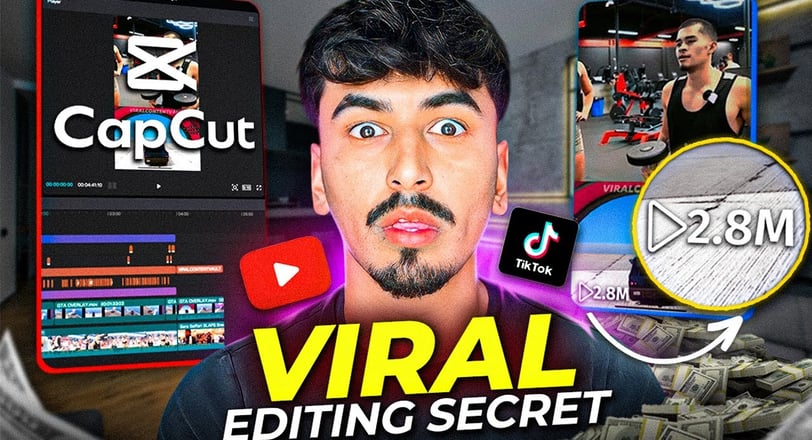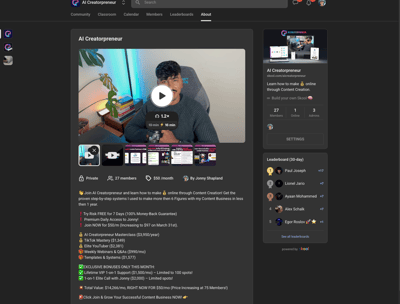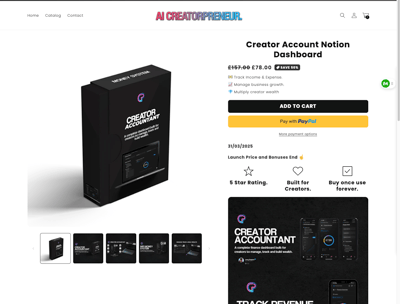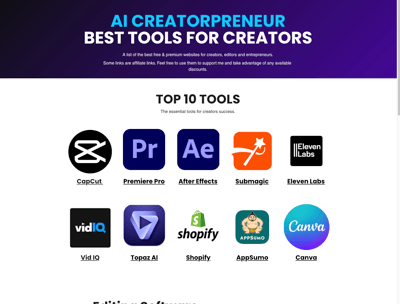How to Edit Viral Podcast Clips: Complete Guide for 2025
Learn how to edit viral podcast clips for TikTok, YouTube Shorts, and Instagram. Step-by-step tutorial with free resources to start making money with short-form content.
Jonny Shapland
7 min read


How to Edit Viral Podcast Clips: Complete Guide for 2025
Introduction
Short-form content is making people an insane amount of money right now. All the social media platforms are literally begging for creators to move over to them and incentivising them with substantial payouts. As mentioned in the video, some creators are making up to $20,000 per month just from editing videos on their phones and posting them to TikTok.
If you've been watching TikTok or YouTube Shorts lately, you've probably noticed the explosion of podcast clip content. These clips typically feature entertaining moments from popular podcasts, often with eye-catching visuals, captions, and effects. What you might not realize is that these clips represent one of the most accessible opportunities to start making money online in 2025.
The problem? Most people don't actually know how to properly edit these clips. They hear advice like "grab a viral clip, put some GTA footage over it, add captions, and post it on TikTok," but the actual execution requires specific techniques that aren't obvious to beginners.
That's where this guide comes in. I'm going to show you exactly how to assemble these clips step-by-step, with all the resources you need to get started immediately. Whether you're looking to take advantage of the TikTok Creativity Program, YouTube Shorts monetisation, or simply build a skill that's in high demand, this comprehensive tutorial will give you everything you need.
Disclosure: This post contains affiliate links. If you purchase through these links, I may earn a commission at no additional cost to you.
Why Podcast Clipping is a Lucrative Opportunity in 2025
Short-form content platforms are experiencing unprecedented growth, and they're willing to pay creators to keep users engaged. Here's why podcast clipping specifically represents such a valuable opportunity:
TikTok Creativity Program
The TikTok Creativity Program Beta is now available in many countries, offering creators a way to earn directly from their content based on views and engagement. This program specifically rewards creators who produce videos between 1-3 minutes long—perfect for podcast clips.
Want to see exactly how this program works? Check out my YouTube tutorial at 1:20 where I explain the requirements and potential earnings.
Multiple Monetisation Avenues
Beyond platform-specific programs, podcast clipping opens up several revenue streams:
Platform monetization: Direct earnings from TikTok, YouTube Shorts, and other platforms
Client work: Many podcasters will pay editors to clip their content
Affiliate marketing: Promoting products related to the podcast topics
Building your own audience: Eventually transitioning to your own content
Low Barrier to Entry
Unlike many online opportunities, podcast clipping requires:
No face on camera
No specialized equipment
No prior following
Minimal technical skills (which you'll learn in this guide)
The key is understanding the specific editing techniques that drive engagement—which is exactly what we'll cover next.
Three Proven Podcast Clip Editing Styles
Through testing and analysing top-performing clips, I've identified three distinct editing styles that consistently generate high engagement. Let's break down each one:
Style 1: Split-Screen with GTA Gameplay
This style features the podcast video on the bottom half of the screen with gameplay footage (typically GTA) on the top half. It's currently one of the most popular formats on TikTok.
Key elements:
50/50 screen split
Subtle branding overlay
Auto-generated captions
Quality filters
Strategic text highlights
For a detailed breakdown of the split-screen editing style, watch at 7:45 in my YouTube tutorial where I show the exact CapCut settings to use.
Why it works: The gameplay footage provides constant visual stimulation while viewers listen to the podcast content. This keeps viewers engaged even during less visually interesting podcast moments.
Style 2: 1:1 Ratio with Blurred Background
This style presents the podcast clip in a square (1:1) format in the center of the screen with a blurred, enlarged version of the same clip as the background.
Key elements:
Center-positioned square video
Blurred background effect
Hook text at the top
Minimal editing required
Clean, focused presentation
Learn how to create the 1:1 ratio style with blurred background at 14:20 in my YouTube tutorial where I demonstrate this technique step-by-step.
Why it works: This style creates a clean, professional look that draws attention to the center of the screen. It's also one of the fastest styles to produce, making it perfect for high-volume content creation.
Style 3: Full-Screen with Dynamic Framing
This style uses the full vertical screen space with dynamic framing that shifts between speakers using keyframes.
Key elements:
Full-screen vertical format
Dynamic speaker tracking
Professional-looking filters
Branded lower third
Highlighted caption moments
See how to implement dynamic framing for full-screen clips at 19:30 in the original video where I walk through the keyframing process.
Why it works: This style creates the most immersive viewing experience and looks the most professional. It performs exceptionally well on platforms like YouTube Shorts and Instagram Reels.
Essential Tools and Resources You Need
Before diving into the editing process, let's make sure you have everything you need:
Editing Software
CapCut is my recommended editing software for podcast clips because:
It's completely free
Available on both mobile and desktop
Includes auto-caption features
Offers professional-quality effects
Has an intuitive interface for beginners
Source Material
For podcast clips, you'll need:
Podcast footage: Screen recorded from YouTube or podcast platforms
Gameplay overlays: I've provided GTA gameplay clips in the resources below
Viral sounds: Background music that enhances engagement
Free Resources Package
I've created a comprehensive resource package for you that includes:
GTA gameplay overlays
Viral sound effects
Podcast clip examples
CapCut templates
Google Doc with step-by-step instructions
You can access all these resources here: Google Drive Resources
I demonstrate how to add engaging captions and text effects at 25:15 in my tutorial, showing exactly how to use these resources effectively.
Step-by-Step Editing Process
Now let's break down the exact process for creating viral podcast clips:
Finding and Recording Quality Clips
Identify popular podcasts in your niche or interest area
Search for interesting moments by watching at 2x speed
Take timestamps of compelling segments (controversial statements, funny moments, valuable insights)
Screen record the clips from your mobile device for best audio quality
Organize your clips with descriptive filenames
Pro tip: When screen recording, use your phone rather than your computer to avoid echo issues with the audio.
Want to see exactly how I find and record high-quality podcast clips? Check out my YouTube tutorial at 2:30 where I demonstrate this process step-by-step.
Setting Up Your Project in CapCut
Create a new project in CapCut
Set the aspect ratio to 9:16 (vertical)
Import your podcast clip and position it appropriately based on your chosen style
Add your overlay (GTA gameplay or blurred background)
Apply a quality filter to enhance visual appeal
For advanced retention strategies including the hook optimization technique, watch at 32:40 in the video where I show how to create loops that maximise watch time.
Adding Captions and Visual Elements
Generate auto captions using CapCut's built-in feature
Customise the caption style (font, colour, animation)
Add emphasis text for key moments
Include your branding (subtle watermark or logo)
Highlight important words in different colours
Caption optimisation tips:
Use contrasting colours for readability
Keep font size consistent
Position captions in the middle of the screen
Use animations that don't distract from content
Implementing Transitions and Effects
Add a hook at the beginning (the most interesting part of the clip)
Create smooth transitions between different segments
Add background music at appropriate volume levels
Implement pattern interrupts to maintain attention
End with a loop back to the beginning for replay value
Learn about my cross-platform distribution strategy at 38:20 in the video to maximize your content reach and ensure your clips perform well across all platforms.
Advanced Editing Techniques for Higher Engagement
Once you've mastered the basics, these advanced techniques will help your clips stand out:
Hook Optimisation
The first 3 seconds of your clip determine whether viewers will keep watching. Here's how to create irresistible hooks:
Identify the peak moment of your podcast clip
Move it to the beginning of your video
Add a transition effect (like a camera shutter)
Return to chronological order after the hook
Create a seamless loop back to the hook at the end
This creates what I call an "infinite loop" that encourages multiple watches and boosts your retention metrics.
Strategic Text Highlights
When speakers say something particularly impactful or funny, emphasize it with:
Pop-up text in a different style than your captions
Emoji reactions that match the emotional tone
Color changes for emphasis
Size variations for dramatic effect
Strategic positioning to draw the eye
I've created a step-by-step CapCut editing tutorial on my YouTube channel that covers these techniques in detail. You can watch it at 35:10 to master these advanced methods.
Audio Enhancement
Don't neglect the audio component of your clips:
Normalise volume levels between different speakers
Add subtle background music that matches the content tone
Implement strategic sound effects at key moments
Use J-cuts to create seamless audio transitions
Fade music during important statements
Monetisation Strategies Beyond Platform Payouts
While platform monetisation is great, here's how to maximise your earnings:
Cross-Platform Distribution
Don't limit yourself to one platform. Use tools like Repurpose.io to automatically distribute your content across:
TikTok
YouTube Shorts
Instagram Reels
Facebook Reels
Twitter/X
Each platform represents a separate revenue stream for the same content.
Building Niche-Specific Channels
Rather than creating a general podcast clips channel, consider focusing on specific niches:
Finance podcast clips
Comedy podcast moments
Relationship advice highlights
Business insights compilations
Celebrity interview snippets
Niche-specific channels attract more targeted audiences and often command higher CPMs.
Attracting Clients as an Editor
Once you've built a portfolio of well-edited clips:
Reach out to podcasters who don't have a strong short-form presence
Offer a revenue-sharing model or flat fee structure
Demonstrate your value with engagement metrics
Create a simple service package with clear deliverables
Scale by hiring other editors as you grow
Many podcasters understand the value of short-form content but lack the time or skills to create it themselves.
Common Challenges and Solutions
As you embark on your podcast clipping journey, here are some common challenges you might face and how to overcome them:
Challenge: Finding Engaging Content
Solution: Follow podcast aggregators and trending topics. Use VidIQ to identify which podcast clips are already performing well, then find similar content from other sources.
Challenge: Maintaining Consistent Output
Solution: Batch your content creation. Set aside one day to find and screen record clips, another day for editing, and use scheduling tools to maintain a consistent posting schedule.
Challenge: Standing Out in a Crowded Space
Solution: Develop a unique editing style or focus on underserved podcast niches. Consider adding your own brief commentary or insights to differentiate your clips.
Challenge: Copyright Concerns
Solution: Focus on transformative content that adds value through editing, captions, and visual elements. Many podcasters welcome clips as they drive traffic to their full episodes.
I address the most common roadblocks and how to overcome them in my FAQ section at 48:30 in the original video.
Conclusion: Your Next Steps
The short-form content revolution is creating unprecedented opportunities for creators who understand how to edit engaging podcast clips. With the techniques and resources provided in this guide, you're now equipped to start creating content that can generate views, followers, and income across multiple platforms.
To recap your next steps:
Download the resources package from the Google Drive link
Choose your preferred editing style from the three options we covered
Find and record your first podcast clip using the techniques described
Edit following the step-by-step process outlined above
Distribute across multiple platforms to maximise your reach
Analyse performance and refine your approach based on data
Remember, consistency is key.
The creators seeing the most success are those who publish regularly and continuously refine their editing techniques based on performance.
For additional support and to connect with other creators, consider joining my Skool Community where we share tips, feedback, and opportunities.
Have you tried editing podcast clips before? What style works best for you? Let me know in the comments below!

Watch the Full Video Here
Get Started Right Now For Free
Everything you need to succeed as a creator.
Inside the AI Creatorpreneur Eco system we have all that an aspiring content creator needs to have success in 2025.
Creator Community


3x weekly calls with Jonny
30+ hours of course content
Community of like minded entrepreneurs




Product Store
Shop the Creatorpreneur store for essential Presets, templates and tools to rapidly improve and scale your creator business.
A list of the best free & premium AI Tools and software for creators, editors and entrepreneurs.
Essential Tools
If you can Dream it, Speak it, and Believe it.
You can Create it.
Unlock your potential and achieve success with AI.
Connect
© 2025. All rights reserved.
